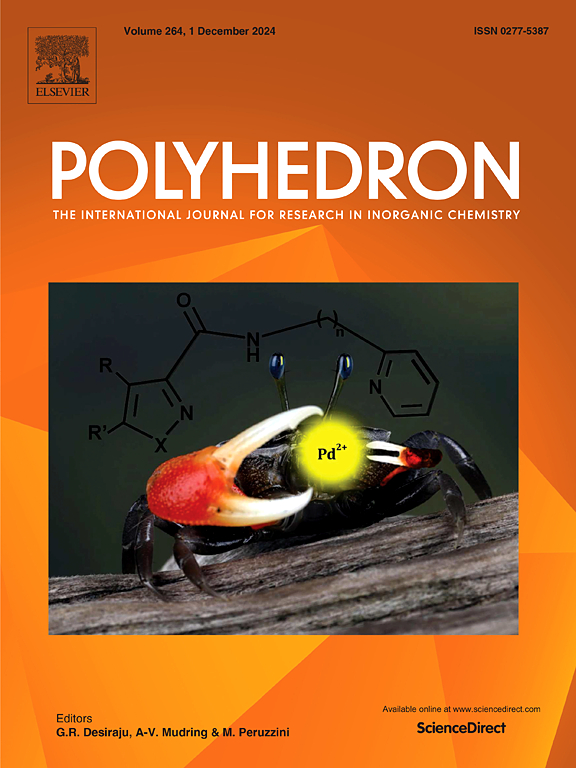Synthesis, structural and photocatalytic properties of ZnO-CuO, ZnO-Graphene and ZnO-CuO-Graphene nanocomposites
IF 2.4
3区 化学
Q2 CHEMISTRY, INORGANIC & NUCLEAR
引用次数: 0
Abstract
Industrial wastes particularly organic dyes has been a matter of great challenge in the rapid growing industrial technologies. To address this issue nanocomposites of ZnO-Graphene, ZnO-CuO and ZnO-CuO-graphene were efficiently developed via chemical co-precipitation method and inestigated its photocatalytic properties for efficient waste water treatment in the degradation of methylene blue (MB) as an indicator. These nanocomposites were fully characterized by numerous advanced characterization techniques i.e. X-ray Diffraction (XRD), Fourier Transform Infrared spectroscopy (FTIR), UV–visible spectroscopy, Scanning Electron Microscopy (SEM), Energy Dispersive X-ray (EDX) Spectroscopy, and Photoluminescence (PL). The SEM image of ZnO-CuO-Graphene nanocomposite revealed flower-like morphology while the presence of Zn, Cu, O, and C were confirmed by EDX spectroscopy. Low PL intensity of ZnO-CuO-Graphene nanocomposite indicates low electron-hole recombination indicating it is a potential photocatalyst for photocatalysis application. Among all nanocomposites, ZnO-CuO-Graphene nanocomposite possesses greater photocatalytic activity after 180 min while exposed to solar light i.e. 81 % degradation of MB dye copared to 74 % and 77 % degradation by ZnO-G and ZnO-CuO nancomposites respectively. The incremental photocatalytic efficiency of the ZnO-CuO-Graphene nanocomposite is predominantly due to the larger active surface area resulting from the incorporation of Graphene.

ZnO-CuO、zno -石墨烯和ZnO-CuO-石墨烯纳米复合材料的合成、结构和光催化性能
在快速发展的工业技术中,工业废料特别是有机染料已成为一个巨大的挑战。为了解决这一问题,采用化学共沉淀法制备了zno -石墨烯、ZnO-CuO和ZnO-CuO-石墨烯纳米复合材料,并以亚甲基蓝(MB)为指示剂,研究了其光催化性能。这些纳米复合材料通过许多先进的表征技术,即x射线衍射(XRD),傅里叶变换红外光谱(FTIR),紫外可见光谱,扫描电子显微镜(SEM),能量色散x射线(EDX)光谱和光致发光(PL)进行了全面表征。zno - cuo -石墨烯纳米复合材料的SEM图像显示出花状形貌,EDX光谱证实了Zn、Cu、O和C的存在。zno - cuo -石墨烯纳米复合材料发光强度低,电子空穴复合率低,是一种潜在的光催化材料。在所有纳米复合材料中,ZnO-CuO-石墨烯纳米复合材料在太阳光照射180分钟后具有更强的光催化活性,对MB染料的降解率为81%,而ZnO-G和ZnO-CuO纳米复合材料的降解率分别为74%和77%。zno - cuo -石墨烯纳米复合材料的光催化效率的增加主要是由于石墨烯的加入导致了更大的活性表面积。
本文章由计算机程序翻译,如有差异,请以英文原文为准。
求助全文
约1分钟内获得全文
求助全文
来源期刊

Polyhedron
化学-晶体学
CiteScore
4.90
自引率
7.70%
发文量
515
审稿时长
2 months
期刊介绍:
Polyhedron publishes original, fundamental, experimental and theoretical work of the highest quality in all the major areas of inorganic chemistry. This includes synthetic chemistry, coordination chemistry, organometallic chemistry, bioinorganic chemistry, and solid-state and materials chemistry.
Papers should be significant pieces of work, and all new compounds must be appropriately characterized. The inclusion of single-crystal X-ray structural data is strongly encouraged, but papers reporting only the X-ray structure determination of a single compound will usually not be considered. Papers on solid-state or materials chemistry will be expected to have a significant molecular chemistry component (such as the synthesis and characterization of the molecular precursors and/or a systematic study of the use of different precursors or reaction conditions) or demonstrate a cutting-edge application (for example inorganic materials for energy applications). Papers dealing only with stability constants are not considered.
 求助内容:
求助内容: 应助结果提醒方式:
应助结果提醒方式:


